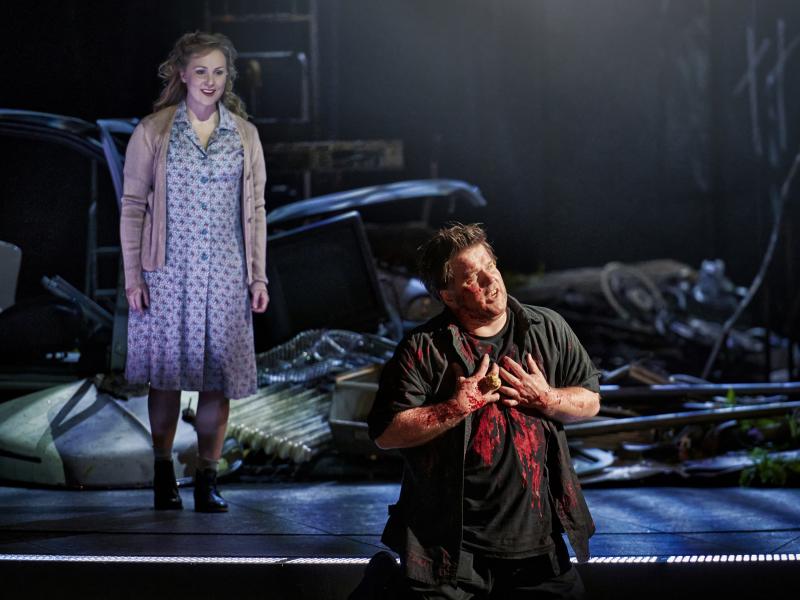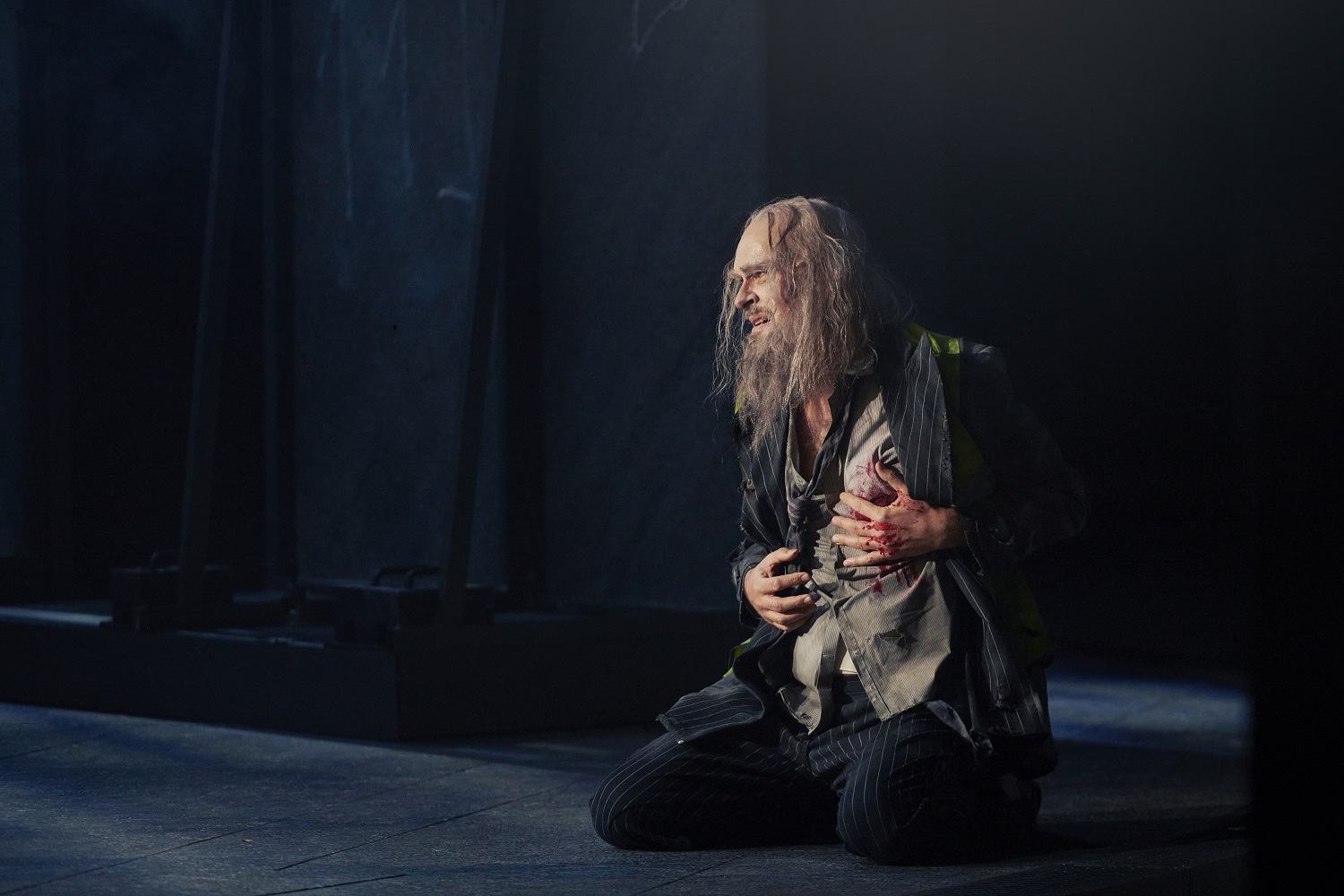Siegfried, Göteborg Opera online review - a hero for our times | reviews, news & interviews
Siegfried, Göteborg Opera online review - a hero for our times
Siegfried, Göteborg Opera online review - a hero for our times
Staging and singing in sync for the Ring’s scherzo

The team of Stephen Langridge (director), Alison Chitty (design) and Paul Pyant (lighting) produced a quietly radical Parsifal at the Royal Opera in 2013, finding both beauty and horror in unexpected corners.
This is billed as a “green” Ring by an environmentally friendly opera house. It’s a notion which, I fancy, would have intrigued Wagner the theorist, dreamer and pragmatist, who originally entertained the notion of building a Bayreuth for the Ring and then burning it down, but whose dramaturgy time and again emphasises our responsibilities to those around us and those to come. There is, in the opening scene’s factory setting and partially effaced slogans, a functional symbology of reduce – reuse – recycle which carries through to the junkyard of Neidhöhle – Fafner’s lair – and Brünnhilde’s mountaintop, which resembles nothing so much as a Brancusi rock installation.
Some small touches make big effects in an opera of one-to-one dialogues and down-to-earth settings. Brünnhilde’s grey wig illustrates more succinctly than reams of backstory exegesis that promises of eternal youth mean as little in the Ring as they do in a face-cream advert. In Fafner’s bedraggled locks and dirty council-worker tabard is captured the modern image of the miser and loner, inspiring a pity worthy of his dying words (the excellent Mats Almgren, pictured below). Wagner wrote dialogues, but the Gothenburg stage is busy with extras. Siegfried’s dream – every straight man’s fantasy – of a warrior maiden lying defenceless on a rock just waiting to be rescued – gains a certain, contemporary realism but also sympathy from the crew who helpfully loosen Brunnhilde’s stays, etc. At other times their ubiquitous presence feels like a distancing device too far: the first scene’s workplace banter, the everyman fellow in grey overalls who laughs at talk of dragons and fire and watches on while Mime and Alberich argue the toss.
Wagner wrote dialogues, but the Gothenburg stage is busy with extras. Siegfried’s dream – every straight man’s fantasy – of a warrior maiden lying defenceless on a rock just waiting to be rescued – gains a certain, contemporary realism but also sympathy from the crew who helpfully loosen Brunnhilde’s stays, etc. At other times their ubiquitous presence feels like a distancing device too far: the first scene’s workplace banter, the everyman fellow in grey overalls who laughs at talk of dragons and fire and watches on while Mime and Alberich argue the toss.
Langridge’s staging of Parsifal called out for a leaner, 5% fat account of the score than it received from Antonio Pappano, and in this respect Evan Rogister’s conducting is more to the point. His flexible, transparently balanced reading makes a virtue of necessity from the slightly reduced, socially distanced forces ranged across the raised pit, though coordination problems still inevitably arise in the one-to-a-desk strings; the Prelude to Act 3 flickers into life like a low-energy bulb.  The casting is almost wholly strong, weakened only by a third-act Wanderer (Anders Lorentzson) apparently standing in for the marvellously bluff and grizzled Fredrik Zetterström of the first two acts. Dan Karlström sings a characterful but uncaricatured Mime. Hege Høisæter’s Erda married warmth with resonance. Ingela Brimberg (pictured above) has the measure of Brünnhilde’s final top C as well as lending an unforced, lyric tenderness to her tricky awakening. Best of all, she was never in danger of outsinging the tireless Daniel Brenna in the title role. Not since Gary Lehman as Tristan a decade ago have I heard a Wagnerian tenor as capable of both honeyed tone in reflection and ringing declamation. Siegfried is only a heedless bully if he is made to look and sound like one; Brenna, Langridge and Rogister between them present a much deeper portrait of this very modern anti-hero.
The casting is almost wholly strong, weakened only by a third-act Wanderer (Anders Lorentzson) apparently standing in for the marvellously bluff and grizzled Fredrik Zetterström of the first two acts. Dan Karlström sings a characterful but uncaricatured Mime. Hege Høisæter’s Erda married warmth with resonance. Ingela Brimberg (pictured above) has the measure of Brünnhilde’s final top C as well as lending an unforced, lyric tenderness to her tricky awakening. Best of all, she was never in danger of outsinging the tireless Daniel Brenna in the title role. Not since Gary Lehman as Tristan a decade ago have I heard a Wagnerian tenor as capable of both honeyed tone in reflection and ringing declamation. Siegfried is only a heedless bully if he is made to look and sound like one; Brenna, Langridge and Rogister between them present a much deeper portrait of this very modern anti-hero.
The future of Arts Journalism
You can stop theartsdesk.com closing!
We urgently need financing to survive. Our fundraising drive has thus far raised £49,000 but we need to reach £100,000 or we will be forced to close. Please contribute here: https://gofund.me/c3f6033d
And if you can forward this information to anyone who might assist, we’d be grateful.

Subscribe to theartsdesk.com
Thank you for continuing to read our work on theartsdesk.com. For unlimited access to every article in its entirety, including our archive of more than 15,000 pieces, we're asking for £5 per month or £40 per year. We feel it's a very good deal, and hope you do too.
To take a subscription now simply click here.
And if you're looking for that extra gift for a friend or family member, why not treat them to a theartsdesk.com gift subscription?
more Opera
 La bohème, Opera North review - still young at 32
Love and separation, ecstasy and heartbreak, in masterfully updated Puccini
La bohème, Opera North review - still young at 32
Love and separation, ecstasy and heartbreak, in masterfully updated Puccini
 Albert Herring, English National Opera review - a great comedy with depths fully realised
Britten’s delight was never made for the Coliseum, but it works on its first outing there
Albert Herring, English National Opera review - a great comedy with depths fully realised
Britten’s delight was never made for the Coliseum, but it works on its first outing there
 Carmen, English National Opera review - not quite dangerous
Hopes for Niamh O’Sullivan only partly fulfilled, though much good singing throughout
Carmen, English National Opera review - not quite dangerous
Hopes for Niamh O’Sullivan only partly fulfilled, though much good singing throughout
 Giustino, Linbury Theatre review - a stylish account of a slight opera
Gods, mortals and monsters do battle in Handel's charming drama
Giustino, Linbury Theatre review - a stylish account of a slight opera
Gods, mortals and monsters do battle in Handel's charming drama
 Susanna, Opera North review - hybrid staging of a Handel oratorio
Dance and signing complement outstanding singing in a story of virtue rewarded
Susanna, Opera North review - hybrid staging of a Handel oratorio
Dance and signing complement outstanding singing in a story of virtue rewarded
 Ariodante, Opéra Garnier, Paris review - a blast of Baroque beauty
A near-perfect night at the opera
Ariodante, Opéra Garnier, Paris review - a blast of Baroque beauty
A near-perfect night at the opera
 Cinderella/La Cenerentola, English National Opera review - the truth behind the tinsel
Appealing performances cut through hyperactive stagecraft
Cinderella/La Cenerentola, English National Opera review - the truth behind the tinsel
Appealing performances cut through hyperactive stagecraft
 Tosca, Royal Opera review - Ailyn Pérez steps in as the most vivid of divas
Jakub Hrůša’s multicoloured Puccini last night found a soprano to match
Tosca, Royal Opera review - Ailyn Pérez steps in as the most vivid of divas
Jakub Hrůša’s multicoloured Puccini last night found a soprano to match
 Tosca, Welsh National Opera review - a great company reduced to brilliance
The old warhorse made special by the basics
Tosca, Welsh National Opera review - a great company reduced to brilliance
The old warhorse made special by the basics
 BBC Proms: The Marriage of Figaro, Glyndebourne Festival review - merriment and menace
Strong Proms transfer for a robust and affecting show
BBC Proms: The Marriage of Figaro, Glyndebourne Festival review - merriment and menace
Strong Proms transfer for a robust and affecting show
 BBC Proms: Suor Angelica, LSO, Pappano review - earthly passion, heavenly grief
A Sister to remember blesses Puccini's convent tragedy
BBC Proms: Suor Angelica, LSO, Pappano review - earthly passion, heavenly grief
A Sister to remember blesses Puccini's convent tragedy
 Orpheus and Eurydice, Opera Queensland/SCO, Edinburgh International Festival 2025 review - dazzling, but distracting
Eye-popping acrobatics don’t always assist in Gluck’s quest for operatic truth
Orpheus and Eurydice, Opera Queensland/SCO, Edinburgh International Festival 2025 review - dazzling, but distracting
Eye-popping acrobatics don’t always assist in Gluck’s quest for operatic truth

Add comment